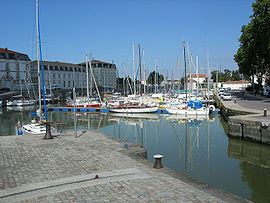Intercommunality Pays Rochefortais Area 21.95 km² Number of airports 1 | Population (2008) 25,676 Local time Monday 10:32 PM | |
 | ||
Weather 11°C, Wind SW at 14 km/h, 91% Humidity Points of interest Musée National de la Marine, Corderie Royale, Musée des Commerces d'Autrefois, Musée Hèbre de Saint‑Clément, Musée national de l'Ancienn | ||
Rochefort ([ʁɔʃ.fɔʁ]) is a commune in southwestern France, a port on the Charente estuary. It is a sub-prefecture of the Charente-Maritime department.
Contents
Map of 17300 Rochefort, France
History
In December 1665, Rochefort was chosen by Jean-Baptiste Colbert as a place of "refuge, defense and supply" for the French Navy. The Arsenal de Rochefort served as a naval base and dockyard until it closed in 1926.
In September 1757, Rochefort was the target of an ambitious British raid during the Seven Years' War.
Another infrastructure of early Rochefort from 1766 was its bagne, a high-security penal colony involving hard labor. Bagnes were then common fixtures in military harbors and naval bases, such as Toulon or Brest, because they provided free labor. During the Jacobin period of the French Revolution (1790–95), over 800 Roman Catholic priests and other clergy who refused to take the anti-Papal oath of the "Civil Constitution of the Clergy" were put aboard a fleet of prison ships in Rochefort harbor, where most died due to inhumane conditions.
Off Rochefort, from the island of Île-d'Aix where he had spent several days hoping to flee to America, Napoleon Bonaparte surrendered to Captain F. L. Maitland aboard HMS Bellerophon, on 17 July 1815, ending the "Hundred Days".
Rochefort is a notable example of 17th-century "ville nouvelle" or new town, which means its design and building resulted from a political decree. The reason for building Rochefort was to a large extent that royal power could hardly depend on rebellious Protestant La Rochelle, which Cardinal Richelieu had to besiege a few decades earlier. Well into the 20th century, Rochefort remained primarily a garrison town. The tourist industry, which had long existed due to the town's spa, gained emphasis in the 1990s.
Sights
The town is home to a unique style of bridge (built in 1900), named Pont transbordeur de Rochefort
Other sights include:
Personalities
Rochefort was the birthplace of:
International relations
Rochefort is twinned with:
